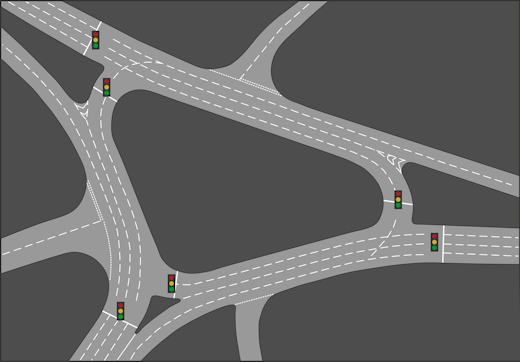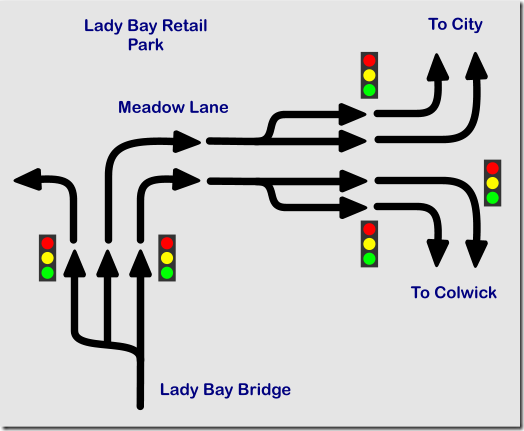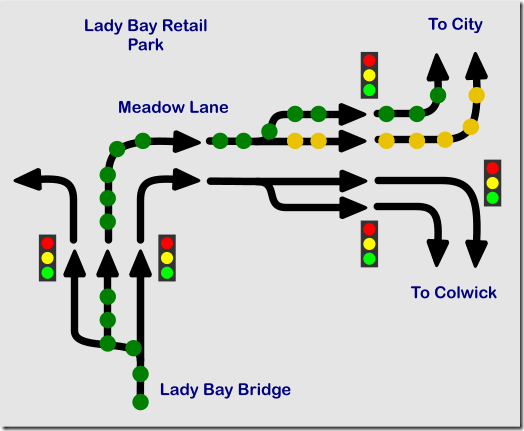One of the most common reasons pupils fail their tests is by not maintaining lane discipline on roundabouts.

I’ve noticed over the years that – from time to time – you get instructors who have read a few pages out of Roadcraft, and who have subsequently decided they’re going to teach their pupils to drive like police pursuit drivers from now on. It quickly develops into the inevitable boasting about how they get theirs to straight-line roundabouts.
Frankly, it’s a stupid idea to do that with 17-year old novices. When they’re under pressure, most of them are barely aware that there even any lanes there when they enter a roundabout, and even the normal observations and control are likely to suffer. With the additional checks needed if you’re going to skip lanes, the chances of something going wrong just increase. Furthermore, straight-lining is intended to allow police drivers to maintain speed, and that’s pretty much the last thing you should be encouraging 17-year olds to do.
I vividly remember an end-of-test debrief some years ago for a pupil who had failed with one serious fault. It occurred on the Virgin roundabout in Colwick, which basically has a two-lane dual carriageway going in, and two lanes coming out (therefore, two lanes on it, even though it is unmarked, and on the return to the test centre these are narrow). The examiner’s words were as follows:
I asked you to follow the road ahead at the roundabout. You approached it in the left-hand lane, and you straight-lined it – which is perfectly OK – but you didn’t check your mirrors to see if there was anyone in the lane to your right.

I have never forgotten that, and I use it on my lessons frequently. However, the pupil in question (and many others since when we’ve been dealing with roundabouts) didn’t have a clue what the examiner was talking about. At the precise moment it happened, he was thinking of a hundred other things. He knew, of course, that there were lanes, but when it came to do it – with the pressure of the test and all the stuff that happens inside people’s heads when they’re on a roundabout in that situation – he didn’t. That’s how it is for most learners, and if instructors are skimming over that to play with the big boys’ toys in Roadcraft, they’re doing those pupils a disservice.
I teach all of mine that staying in lane is the best policy, and they can play at being smart arses once they’ve passed and gained more experience around the nutcases infesting the roads these days. If nothing else, learning to stay in lane is a solid foundation on which to build your later skills – it’s a stepping stone to driving like a smart arse, if you like. If you’ve never been taught to maintain good lane discipline, but you have been shown advanced (and often pointless, for normal drivers) techniques that develop out of it, sooner or later you’re going to have trouble. And your driving test is an excellent place for that trouble to make itself known.

How an instructor teaches roundabout lane discipline varies from pupil to pupil. Some will pick it up quickly with no problems at all, but getting it over to others can be a huge challenge.
I used to have a big notebook of plain paper (nowadays I use a DoogleBook), and I frequently do sketches of roundabouts (and other things) to get the point I’m trying to make across. Sometimes, you get pupils who simply don’t get diagrams, and you have to resort to words and analogies with things they are familiar with (which can be a pain these days, as an increasing number of them appear to have absolutely no outside interests you can draw upon).
I also use graphics I have produced and laminated, like the ones above (these days I can sketch them in a few moments on my DoogleBook). The arrow diagrams show how the lanes on the approach from one direction to the main Colwick roundabout work, and which ones you’d use depending on where you are going. The one at the top is an accurate representation of the same roundabout with lane markings (click it to see the full sized version), and I have these for all the tricky roundabouts – not just the test ones. It means we can pull over and discuss what happened, and what ought to have happened.
As I have explained in the article about roundabouts, they nearly all work along the same basic principles, no matter how big and apparently complex they are. Even the largest can be broken down into a series of smaller parts that work exactly the same way as they do on smaller ones. Knowing how to do the smaller parts allows you to piece them together like a jigsaw puzzle when applying them on different roundabouts.
When it comes down to it, any large problem is just a collection of smaller ones. So as you learn, you learn to solve each small problem on its own, and over time put the pieces together so that you end up with an overall solution.